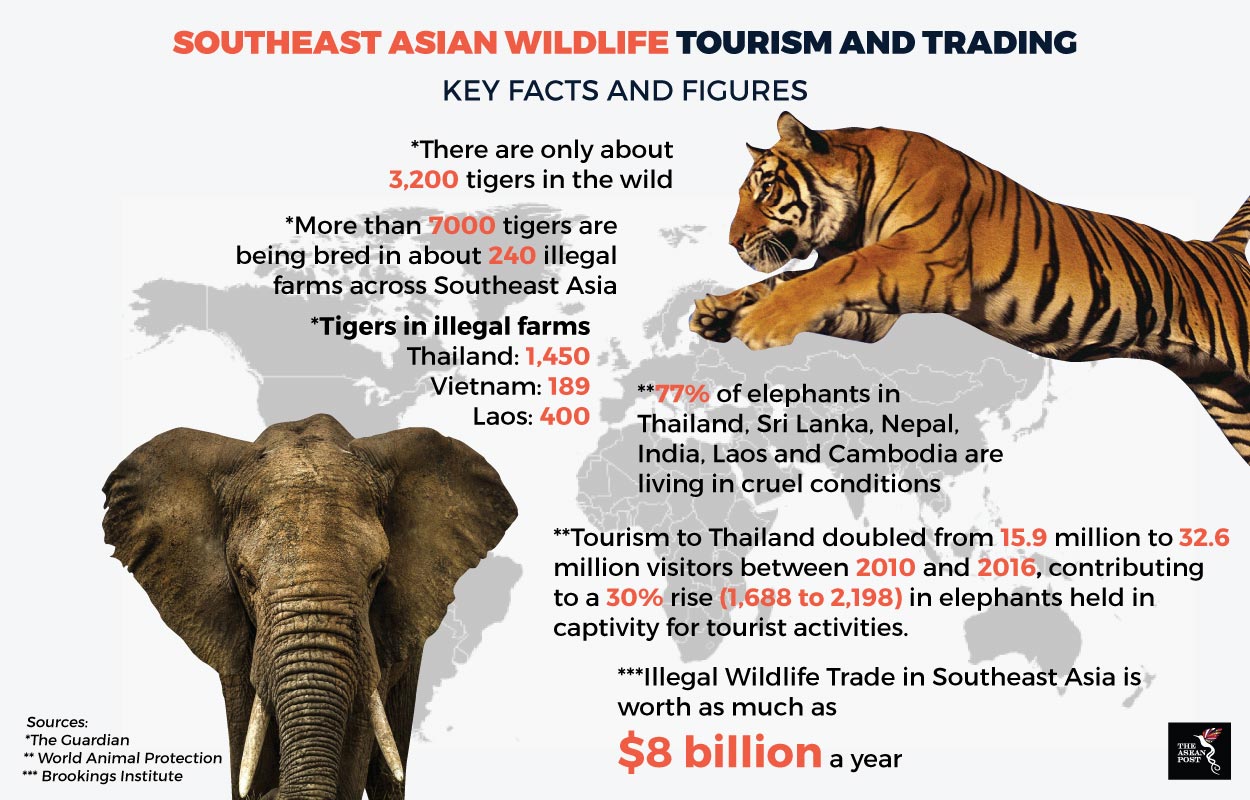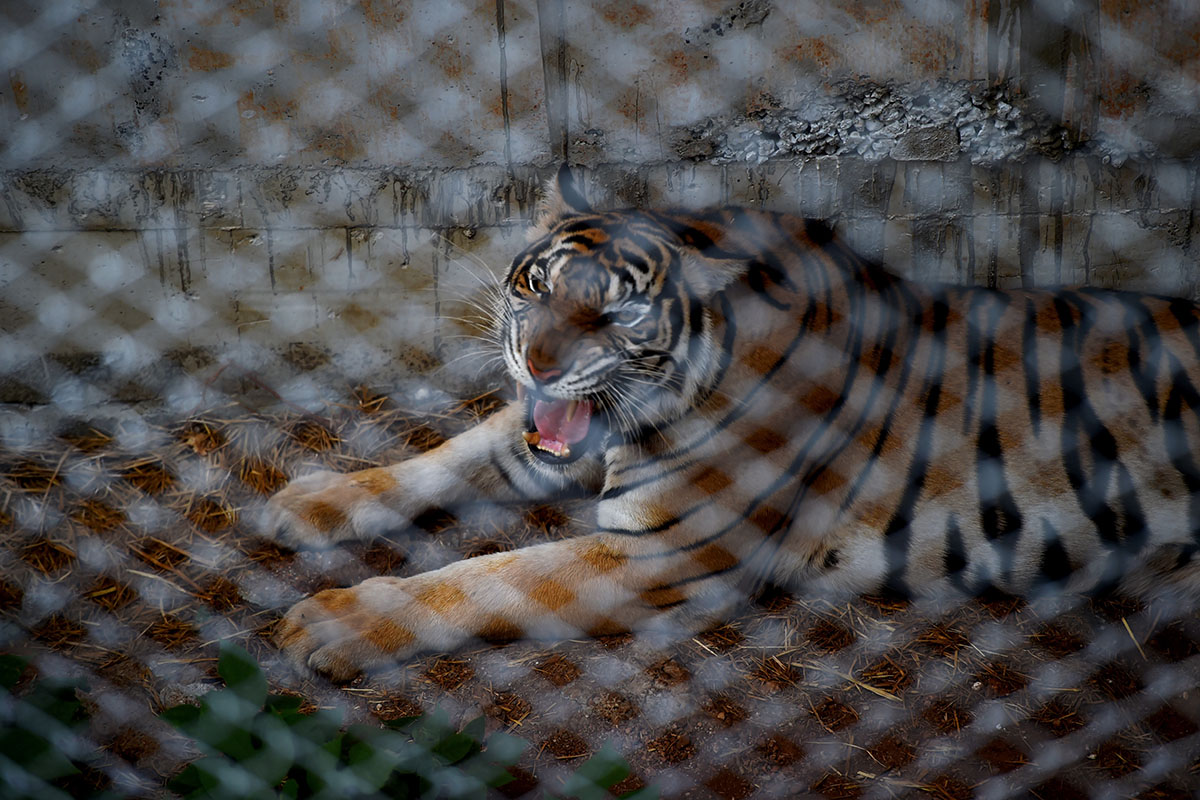One of the best things about Southeast Asia is that it’s home to lush, green rainforests and extremely diverse wildlife. This is probably one of the many reasons why – according to the World Travel and Tourism Council (WTTC) – over one hundred million tourists flocked to the region in 2016. However, as more and more tourists arrive, opportunists are taking advantage of this growth to prop up shady businesses that seek to cash in on the growing demand for wildlife tourism. Even worse, some of these businesses are also implicit in the illegal wildlife trade that’s rife within Southeast Asia.
A tiger park is one of the more popular attractions in Thailand where tourists can take photographs and “selfies” with tigers and tiger cubs. Animals Asia, an animal rights and welfare organization has raised concerns about the welfare of tigers in such parks. According to a report by Animals Asia, tiger cubs used as photo props are often taken from their parents at a very early age. “If taken from the wild, the cub’s parents will doubtless be killed in the process,” the report added.
There is also speculation that some of these parks are involved in illegal wildlife trading. In June 2016, Thailand’s Tiger Temple, a popular tourist destination in Kanchanaburi Province, was raided after reports that the tigers there were being abused and that the Buddhist monks who run the temple were taking part in illegal breeding and animal trafficking. According to the BBC, over 100 tigers were rescued during the enforcement operation.

Elephants are popular among tourists who come to the region. According to a report by The Guardian last year, about 40% of tourists from the top 10 countries visiting Thailand said that they were planning to take an elephant ride. However, a report by World Animal Protection (WAP) in July, 2017 revealed that most elephants used for wildlife tourism in Asia face cruelty and are kept in deplorable conditions. The WAP conducted an investigation into the living conditions of 2,923 elephants at tourist attractions in Thailand, Cambodia, Lao, Sri Lanka, Nepal and India and found that 77% of these elephants were “treated appallingly” – with Thailand being singled out as the location of most concern by the WAP. The report also indicated that as tourism doubled in Thailand from 2010 to 2016, the rise had contributed to a 30% increase in tourist activities related to elephants.
Elephants are considered an endangered species by the International Union for Conservation of Nature. According to Animals Asia, most elephants used in wildlife tourism go through a process called “phajaan” – which when literally translated from Thai means “to crush” – before they can start carrying tourists. The process involves young elephants being taken from their mothers at an early age and placed in small wooden cages. They are then beaten until they are “crushed”, making them docile and obedient enough for humans to train. Chiara Vitali, a wildlife expert at World Animal Protection says that cruelty in the elephant industry is “a hidden form of cruelty” as tourists don’t usually witness this brutality. Despite that, tourists often contribute to the mistreatment of elephants as elephant rides usually involve elephants carrying heavy loads in high temperatures all day. There have even been reports in the Vietnamese media of elephants dying due to being overworked.
One side effect of the growing demand for elephant rides and tiger selfies is that it could also fuel illegal wildlife trading. In a New York Times expose, Rachel Nuwer revealed that the zoo run by the Kings Roman Group in Lao was being used to actually farm exotic animals for slaughter and trafficking.
The Guardian reported that there are approximately 700 tigers living on farms in Lao with thousands more being kept in similar conditions all over Southeast Asia. Sadly, Rachel Nuwer added that the number of tigers being kept on such farms currently outnumber the 4,000 tigers living in the wild.
ASEAN governments have been taking steps to prevent the region from becoming a hub for illegal wildlife trade. Ever since the formation of the ASEAN Wildlife Enforcement Network (ASEAN-WEN) in 2005, enforcement efforts have been improving. The Rappler reported that wildlife and human counter-trafficking organization Freeland has credited ASEAN-WEN for the 11-fold increase in confiscated wildlife contraband since 2008. Thailand has also made efforts to improve the conditions of its captive elephants. The BBC reported that the Thai government has set up an elephant database and has strengthened the policing of its border with Myanmar - where many of these elephants come from. Regional governments should also strictly regulate wildlife tourism, or even promote sanctuaries that are known to actually care for the elephants. As these industries are also driven by demand, local governments could play a more active role in educating tourists of the harmful effects of their participation in wildlife tourism.
Recommended stories:
